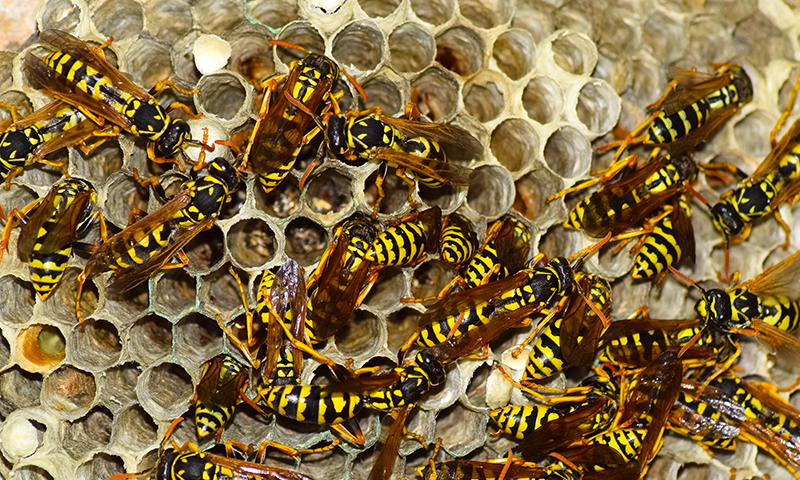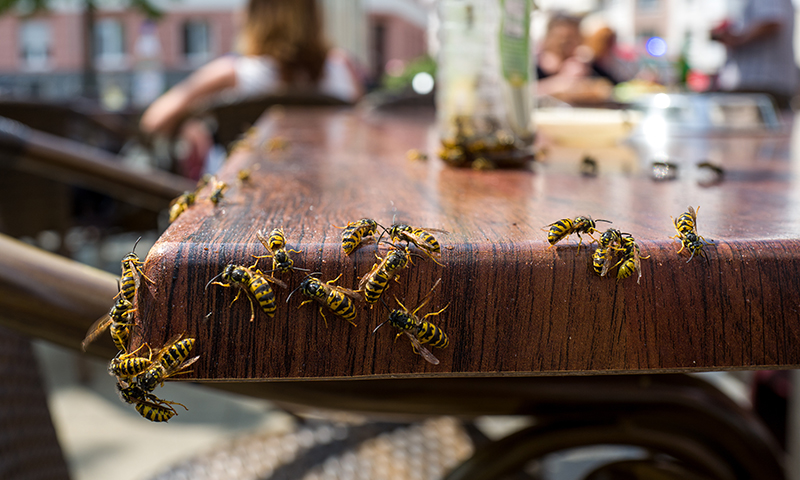How to Kill and Control Wasps
Wasps comprise a large group of flying insects, including hornets and yellow jackets. Though many wasps aren't aggressive, some species threaten people, pets and wildlife. Unlike honeybees, which can only sting once, wasps can sting repeatedly. They can also signal for other wasps to come and join in. Understanding these flying insects can help you get rid of wasps and protect your family against their painful stings.

Female wasps have smooth stingers that can sting repeatedly.
Identifying Common Wasps
North America has thousands of wasp species, but only a few dozen cause trouble for people and pets. Common wasps have hard, glossy, nearly hairless bodies with pinched, narrow waists. In contrast, common bees have fuzzy hair. The most aggressive common wasps are yellow and black and grow up to 5/8 inch long. Depending on where you live, these antagonistic stinging pests are known as yellow jackets, paper wasps or just wasps.
Wasp species vary considerably in size and color. Some smaller paper wasps have slender, reddish-brown bodies with yellow bands. Common hornets are yellow and reddish-brown wasps that grow up to 1.5 inches long. Other wasps, known as bald-faced hornets, grow about 7/8 inch in length. Their bodies are black and creamy white. Despite their differences, all wasps have six legs, two antennae and two pairs of slender wings. Only female wasps have stingers, which aid in laying eggs.
One of the simplest ways to identify problem wasp species is by their behavior. Wasps that aggressively scavenge for food and drink at outdoor parties, picnics or restaurants are those most likely to sting with little provocation. While some wasps eat mostly nectar, these nasty pests eat all types of food, including meat.
Wasps that scavenge for human food may also sting aggressively.
Recognizing Wasp Nests
Many types of wasps are solitary insects that nest alone. Some live in small ground nests, while others make small nests of mud. Some types nest in cavities in hollow wood or hollow plant stems. Chances are these solitary wasps live around you, but they never draw attention to themselves.
Other types of wasps are social species. Like ants and honeybees, they live together in colonies that grow larger and larger throughout the year. Depending on the species, their homes look very different. Some make exposed, papery, comb-like nests — often close to where people play or entertain. Others hide massive, enclosed, papery combs in large underground holes or tree cavities. Still others find entry holes in houses and nest in attics and wall voids. Some build large, papery, football-shaped nests that hang from tree branches.
With any kind of wasp, avoid disturbing large nests whenever possible. Never try to get rid of a wasp nest on your own when you suspect a large colony lives there. Wasp colonies can have tens of thousands of members, but nests only last one year. If an active nest must be removed, consult a pest professional for help.

Active wasp nests can contain thousands of wasps, but colonies only last a year.
Protecting Against Wasps
By focusing your treatment efforts on the areas you use most, you can get rid of wasps and protect your family and pets from their return. To maximize your results and minimize your sting potential, treat for wasps when they're least active in early morning and early evening.
Kill existing wasps and protect against new arrivals with Amdro Quick Kill Insect Killer for Lawn & Landscape Ready to Spray or Amdro Quick Kill Insect Killer for Lawn & Landscape Concentrate. These convenient, easy-to-use products work in minutes to kill wasps by contact. Then they keep working to protect against new wasps for up to three months. You can treat lawn areas, landscapes, flower gardens and up to 2 feet high on your home's foundation.
By understanding aggressive wasps and focusing your treatment efforts, you can get rid of wasps and protect against wasp nests and stings. At Amdro, we're here to help you reclaim your yard, put an end to pest disruptions and enjoy your home with family and friends.
Always read product labels and follow the instructions carefully.


